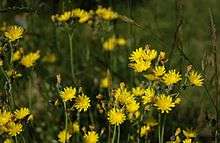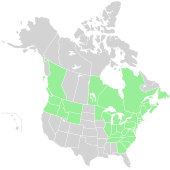Hieracium caespitosum
| Hieracium caespitosum | |
|---|---|
 | |
| Scientific classification | |
| Kingdom: | Plantae |
| (unranked): | Angiosperms |
| (unranked): | Eudicots |
| (unranked): | Asterids |
| Order: | Asterales |
| Family: | Asteraceae |
| Genus: | Hieracium |
| Species: | H. caespitosum |
| Binomial name | |
| Hieracium caespitosum Dumort | |
 | |
| Hieracium caespitosum distribution | |
| Synonyms | |
| |
Hieracium caespitosum (commonly known as meadow hawkweed, yellow hawkweed,[1] field hawkweed,[6] king devil,[7] yellow paintbrush, devil's paintbrush, yellow devil, yellow fox-and-cubs, and yellow king-devil) is like several other Hieracium species and has a similar appearance to many of the other Hawkweeds.[6]
Description
Hieracium caespitosum is a creeping perennial,[8] with shallow, fibrous roots[9] and long rhizomes.[10]
The leaves, hairy on both sides (unlike Hieracium floribundum, which looks similar but has hair only on the underside),[6] are up to 6 inches (15 centimeters) long, spathulate, and almost exclusively basal[9] with the exception of 1 or 2 very small cauline leaves.[10] The leaves lie flat to the ground, overlap, and will smother non-vigorous turf.[8]
The stems are bristly and usually leafless, although occasionally a small leaf appears near the midpoint.[11] Stems, leaves, and bracts have dense, blackish hairs[12] and exude milky juice when broken.[9]
The 1/2 inch (1 centimeter) flower heads appear in tight clusters at the top[9] of the 1 to 3 foot (1/3 to 1 meter) stems with 5 to 40 flowers per cluster.[12] Corollas are all ligulate and bright yellow.[10] Each single flower head is an inflorescence and each petal forms its own seed, making them each a separate flower or floret.
The seeds are shiny, black, and plumed.[11] After maturing they are dispersed by wind, clothing, hair, feathers, and some vehicles that disturb fields or soils. H. caespitosum persists and regrows each year from rhizomes and often spreads by stolons,[13] which can be extensive, creating a dense mat of hawkweed plants (a colony)[12] that practically eliminates other vegetation.[9]
H. caespitosum prefers silt loam, well-drained soil: coarse textures, moderately low in organic matter, and moist.[13] Its presence can be an indicator of low soil fertility or slightly acidic soils.[8]
H. caespitosum has, in the past, been used for healing eyesight. Pliny the Elder had recorded information regarding how other species, specifically hawks, utilized H. caespitosum, specifically believing that they would eat it in an effort to improve eyesight.[7]
Habitat and distribution

Tolerant of drought and trampling, this species finds its habitat where the soil has been neglected. Places like roadsides,[6] neglected residential and commercial landscapes, minimally maintained public parks and open spaces, vacant lots, rubble dump sites, and abandoned grasslands (meadows).[14]
H. caespitosum is an introduced species in North America and can be found in Canada (British Columbia, Manitoba, New Brunswick, Newfoundland, Labrador, Nova Scotia, Ontario, Prince Edward Island, and Quebec)[15] and the United States (Connecticut, Washington D.C., Georgia, Idaho, Illinois, Indiana, Massachusetts, Maine, Michigan, Minnesota, Montana, North Carolina, New Hampshire, New Jersey, New York, Ohio, Oregon, Pennsylvania, Rhode Island, Tennessee, Virginia, Vermont, Washington, Wisconsin, West Virginia, and Wyoming).[1] It is considered a noxious weed in Idaho, Montana, Oregon and Washington.[1]
H. caespitosum's native range includes a large portion of Europe, including Austria, Belarus, Bulgaria, Czechoslovakia, Estonia, France, Finland, Germany, Greece, Hungary, Latvia, Lithuania, Norway, Poland, Romania, Sweden, Switzerland, Ukraine, and Yugoslavia.[16]
References
- 1 2 3 4 Natural Resources Conservation Service (2007). "Plants Profile for Hieracium caespitosum (meadow hawkweed)". The PLANTS Database. USDA, Baton Rouge, LA 70874-4490 USA. Retrieved 2007-12-15.
- ↑ Royal Botanic Garden Edinburgh. "Flora Europaea Hieracium caespitosum". Retrieved 2007-12-15.
- ↑ International Plant Names Index. "International Plant Names Index Search". Retrieved 2007-12-15.
- ↑ Botanic Garden; Botanical Museum Berlin-Dahlem (June 5, 2007). "Details for: Hieracium caespitosum". The Euro+Med Plantbase. Botanic Garden and Botanical Museum Berlin-Dahlem. Retrieved 2007-12-15.
- ↑ The International Plant Names Index (August 21, 2007). "Details for: Hieracium caespitosum". Provisional Global Plant Checklist. International Organization for Plant Information (IOPI). Retrieved 2007-12-15.
- 1 2 3 4 Connecticut Botanical Society (November 13, 2005). "Field Hawkweed". Retrieved 2007-12-15.
- 1 2 Biodiversity at Wellesley College and in New England, Niki Zhou and Carla Holleran (2004-06-25). "King Devil". Landscape Nature Walks. Courtesy Web of Species at Wellesley College. Retrieved 2007-12-20.
For a time, King Devil and other European hawkweeds were used as an herbal remedy for healing eyesight. Pliny reported, in ancient Greece, that hawks ate it to see better.
External link in|work=(help) - 1 2 3 Department of Crop and Soil Sciences, Michigan State University. "Yellow Hawkweed - Hieracium pratense". Weed List. Retrieved 2007-12-15.
- 1 2 3 4 5 Robert H. Callihan; Timothy W. Miller. "Meadow Hawkweed". Idaho's Noxious Weeds. The Idaho Association of Soil Conservation Districts. Retrieved 2007-12-15.
- 1 2 3 Don Knoke, Burke Museum of Natural History and Culture. "Vascular Plants: Hieracium caespitosum". WTU Image Collection: Plants of Washington. Retrieved 2007-12-16.
- 1 2 Utah-Idaho Cooperative Weed Management Area. "Meadow Hawkweed". Noxious and Invading Weeds of the UICWMA. Retrieved 2007-12-16.
- 1 2 3 Erv Evans, Consumer Horticulturist, North Carolina State University. "Hieracium pratense = Hieracium caespitosum". Plant Fact Sheets. Retrieved 2007-12-16.
- 1 2 Cohesive Strategy Team. "Species: Hieracium caespitosum; Meadow hawkweed complex". Cohesive Strategy Team Data. Retrieved 2007-12-16.
- ↑ Harvard Graduate School of Design. "E*view Hieracium pratense". Emergent Vegetation of the Urban Ecosystem. Retrieved 2007-12-15.
- ↑ Flora of North America. "Hieracium caespitosum in Flora of North America". Vol. 19, 20 and 21. pp. Page 278, 280, 284. Retrieved 2007-12-15.
- ↑ Germplasm Resources Information Network. "Hieracium caespitosum". (GRIN) Online Database. USDA, ARS, National Genetic Resources Program. Retrieved 2007-12-15.
External links
 Data related to Hieracium caespitosum at Wikispecies
Data related to Hieracium caespitosum at Wikispecies Media related to Hieracium caespitosum at Wikimedia Commons
Media related to Hieracium caespitosum at Wikimedia Commons- "Machinery That Every Logger Should Have". VanNatta Construction Equipment. Retrieved 2007-12-17.
- Integrated Taxonomic Information System (ITIS). "Standard Report Hieracium caespitosum". Retrieved 2007-12-15.
- "Dicots: Asteraceae, Hieracium caespitosum". TENN Vascular Plants - Database. Retrieved 2007-12-15.
- Forest Pests of North America. "Meadow hawkweed: Hieracium caespitosum". Retrieved 2007-12-15.
- Klinkenberg, Brian. (Editor) 2007. caespitosum "Hieracium caespitosum" Check
|url=value (help). Electronic Atlas of the Plants of British Columbia. Lab for Advanced Spatial Analysis, Department of Geography, University of British Columbia, Vancouver. Retrieved 2007-12-15.